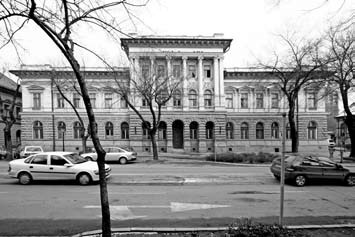A one-storey building that forms an independent urban block. From the west it is surrounded by Štrosmajerova street, from the south by Maksim Gorkog Street, from the east by the Age of Mamužić Street and from the north by Erneo Lanjija. It was built in the period 1880/83. year as a savings bank, the National Bank, according to Titus Mačković’s project, city engineer and city entrepreneur. It was built in an eclectic style with the dominant elements of neo-penance. Rectangular is a base with a longitudinal frontal section oriented towards Štrosmajerova street and a monumental facade designed according to the reputation of the famous Paladia. The prominent facade canvas is emphasized with a representative rationality, ranging from base to attic in two levels. The ground floor is accentuated by rustic squares, characterized by Renaissance palaces, while the sockle is made in the form of proportional squares with mildly emphasized rustics.The rustic wreath follows the line of window openings, running in a rhythmic array along the whole building in the ground floor. The floor is a flat surface with a plastic decoration around the window in the form of pilasters and tympanon, while the window openings are on the balustrades.
On the facade is a central wooden cassette portal with a tympanum above which, on the upper part, massive double-sided pillars and four central slopes with narrowing to the top and the feet of the elongated rectangular shape rise up within the risalite. The base of the columns on the frontal part have a floral ornament made in a ba-relief in squared fields. The captains are Corinthian, with the heads of the road. The windows of the first floor are half-finished and with a balustrade, and double-sided plastic-faced male and female figures with attributes are placed above the window arches. In the northern part of the rhizalite there are two female figures, one holding the cross as an attribute in the right hand, while the other in the left hand holds
Rotulus, and her knees were moved over her knees. In the next pool there is a male figure with a helmet and wings on helmet and sandals (Merkur), and in the right hand holds the arrow.
The female figure in the Greek rigging, as well as all the figures presented on the rizalit, has a hammer in his right hand, and in the left object that could not be identified due to the damage.
The central loggia is with two female figures, one holding a chin and the other box in the form of a cash register. Behind them is a hive, a symbol of savings (the building is erected as a bank building). In the next loft above the window are two female figures, left with an open book, and the right hand holds a hammer in the right hand, while in the left holds a male bust. The last lodge is to the south with two figures, a male with a wheel and a wing, and the woman holds a sickle.
Second-floor windows are placed on floral consoles with side pilasters and tympanons, and the openings are rectangular in shape. This shape of the window holes appears in the rhythmic series at the central rizalite.
On the wall cladding between the two floors are tape-covered boxes in the form of a charter. The ceiling of the balcony, the lofty part of the loggia is tapeed with a profiled wreath. On the consoles there is a roof wreath with an egg, a toothed and floral series that runs around the whole building in the attic section.
The decorative attribute is emphasized over the blocks of rizalite around the whole building. The side windows on the side wings and on the intermediate part are with flat profiled sills on floral consoles.
The roof structure is on four waters, with decorative gutters and water collectors in the sheet.
During the Second World War, the building was a notorious prison and a torture chamber, from which many of Subotica’s residents were taken to other prisons or to the hideouts.
On the façade and in the hall there is a memorial plaque devoted to the events that took place in the “Yellow House” in the period from 1941-1944.
THE “YELLOW HOUSE” BUILDING


0 comments on “THE “YELLOW HOUSE” BUILDING”